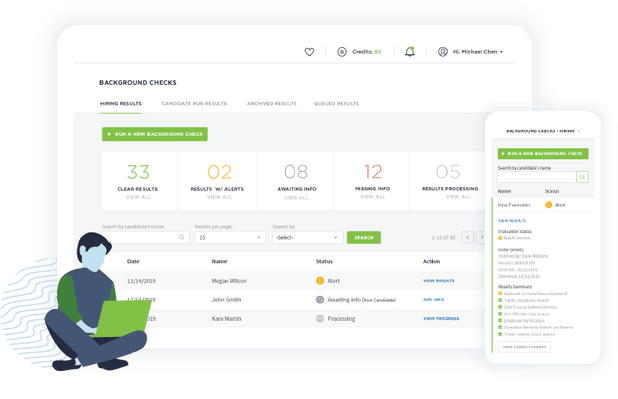5 Tips to Help You Prepare for the Future of Hiring
What does the future of hiring look like? How will you adapt to new and different needs? Our Summit speakers share 5 things HR and recruiting professionals need to know.
Karen Axelton
11 min read
The “Great Resignation” is upon us. From Boomers and Gen X to Millennials and Gen Z, people are rethinking what work really means to them, and many are calling it quits. What does that mean for your recruiting efforts, and how can you adapt your onboarding strategies to improve retention of a multigenerational workforce?
In this blog, experts share eight tips to help you recruit and retain a multigenerational workforce.
The ongoing pandemic has added new challenges to an already difficult environment for hiring managers. As many employees have quit their jobs, labor shortages have worsened, making it more difficult to find and hire qualified employees. There’s an additional challenge: With Baby Boomers remaining in the workforce longer than they might have prior to the Great Recession, workplaces are likely to include people from four different generations.
A diverse, multigenerational workforce brings many benefits for employers, including different perspectives, skills and experiences. But different generations are motivated by different things when it comes to work. To help you successfully recruit and retain a multigenerational workforce, we spoke with HR experts JD Conway, Head of Talent Acquisition at BambooHR and Darby Starnes, Director of Organizational Development at GoodHire to learn some best practices.
To help employers better understand how different generations feel about work, GoodHire recently conducted a survey of 4,000 full-time US workers. We polled an equal number from each working generation, which includes:
Different generations do have different concerns about work. For example, while most generations wish for better work-life balance, what they would sacrifice to get it varies. Baby Boomers would give up career advancement for better work-life balance, while Gen X and Millennials would sacrifice part of their pay.
All generations are united in the desire for higher pay. Just 30% of Baby Boomers, 32% of Generation Z, 42% of Gen X and 47% of Millennials are satisfied with their wages, and better pay is the number-one reason employees of all generations say they would change jobs.
Some of the variations in attitude are simply based on the life stage of the generations. For example, Gen Z, who are just starting out in the workforce, are least likely to be happy at work, feel fulfilled by their jobs, or feel that they have a good work-life balance.
Millennials, who are mostly in the prime of their working lives, are the happiest, most fulfilled, and most satisfied with work-life balance of all the generations. They’re also the most likely to switch jobs in the next 12 months (46%), reflecting that they are at a stage where they’re highly desirable employees. In contrast, just 19% of Baby Boomers are likely to change jobs.
Get tips to improve recruitment & retention. Click to view GoodHire’s on-demand webinar.
view now
While generations may have varying feelings about their work, the keys to hiring people of all ages are essentially the same, according to experts.
Forty-five percent of new hires leave jobs in the first week, often because they don’t feel connected to their new employer, according to a study by BambooHR. Building connections starts with the recruiting process. Whether via social media, a talent platform or sending an email, try to connect each generation with the culture of your company in a way that resonates with them.
Building personal relationships during the hiring process can help build connection from the outset. “Who you work with is a very strong motivator for most people, and we’ve found this to actually be a competitive edge,” says Conway.
That’s one reason each candidate at GoodHire goes through at least five interviews. “We want to make sure this person is introduced to different people throughout the organization,” explains Starnes.
Recruiters, hiring managers and anyone who interviews job candidates should undergo training to ensure the interview process is consistent and accurately conveys the company’s values. “How do we bring our values to life during the recruiting process? How do you live those values? What does that look like?” says Starnes.
Think of the interview process as a chance to “pull back the curtain,” says Conway, “and show candidates what it’s really like to work at your company.” Creating a sense of inclusion helps build trust and psychological safety so candidates feel comfortable in the work environment, no matter what their background, identity or interests.
Employees of all generations want to feel valued and believe that their work matters. You can attract better job candidates by showing that you value what they bring to the job.
“Think about how you are relating the value that this person will bring to this role from Day One,” says Conway. “How does your recruiting process communicate the value of the role to be filled? After the hire, how are you consistently building opportunities for [new employees] to show that value and to have that demonstrated and celebrated?”
When creating job descriptions, distilling the job down to its essence can help you cast a wider net and overcome talent shortages. “I think the origin of diversity problems often starts with the job description,” says Conway. “What are you actually looking for? Are you opening it up or are you closing it down?”
Employers may fixate on a particular level of experience or education, unnecessarily restricting the field of applicants. To help attract a more diverse candidate pool, Starnes advises looking closely at the knowledge, skills, and competencies needed for each job. “Don’t base [the job description] on what the prior employee in that role did, but the core essence of what you envision for that role,” she says.
A willingness to train employees at all levels can also help you attract more job candidates. “Look at upskilling or reskilling,” Starnes advises. “Do they absolutely need [a certain skill] when they walk in the door, or could they be trained if they’re otherwise the right fit?”
To reduce unconscious hiring bias, Starnes suggests masking or anonymizing resumes. Despite hiring managers’ best intentions, clues such as graduation dates or years of experience can cause generational stereotypes to kick in. This could keep otherwise qualified candidates from being considered, such as a Baby Boomer being eliminated for a role based on the belief they won’t be fluent in social media.
After you hire a great candidate, the work of building connection, creating personal relationships, and celebrating value doesn’t stop.
Plan your onboarding process as carefully as your recruiting process. It, too, should incorporate and support your company’s values while helping the new employee feel part of the team.
Start by setting expectations for what the new employee should be doing with their manager. (Most employees want their manager—not HR—to take charge of their onboarding, BambooHR has found.) Make sure these expectations are in alignment with the company culture, support organizational goals, and allow the new worker to feel they are adding value.
Build in frequent check-ins with new employees to ensure they’re satisfied. “Be agile and pivot if you find that something needs to change,” says Starnes. “This goes a long way toward retention.”
New employees care about these “three Cs,” says Conway.
Remote work has taken hold thanks to the pandemic. According to a recent GoodHire survey, the majority of employees would prefer to work remotely. Offering remote work can help you attract more candidates; in fact, the option to work remotely is one of the top two reasons employees would be willing to change jobs.
A remote workforce makes creating connection even more important. Consider using unified communication channels like Slack, having daily huddles, and organizing planned activities that let teams have fun—even remotely. Look for ways to build bonds organically. For example, if your company has locations in different cities, states or countries, Conway suggests creating groups for employees in the same geographic location, so they can form bonds remotely or in person around shared local interests.
Seeking continual feedback from new hires and veteran employees alike is key to successfully retaining your multigenerational workforce. Ask new hires questions and share the answers with the rest of the organization. For example, asking new hires to share their favorite foods, vacation spots, movies, hobbies or other “fun facts” can break the ice with coworkers and help build those all-important connections.
Beyond these questions, ask employees what they need. “What is it your workforce wants to see? What’s working for them and what’s not? What ideas do they have?” says Starnes. Continue to evaluate your company’s initiatives and interventions against employee input, making sure any changes are in alignment with organizational goals.
Hiring a multigenerational workforce benefits your company in many ways. You gain the widest possible range of experience, backgrounds and insights to help your organization stay competitive. By examining your recruiting and retention efforts more closely, and retooling them to reflect the current workforce, you can create a more inclusive, effective and desirable workplace.

The resources provided here are for educational purposes only and do not constitute legal advice. We advise you to consult your own counsel if you have legal questions related to your specific practices and compliance with applicable laws.
What does the future of hiring look like? How will you adapt to new and different needs? Our Summit speakers share 5 things HR and recruiting professionals need to know.
Conducting post-employment background checks on current employees can help protect your business. Here’s how to get started with a post-hire background screening program.
Omitting arrest records that did not result in convictions from criminal background check results benefits both employers and job candidates. Find out why GoodHire excludes non-convictions.